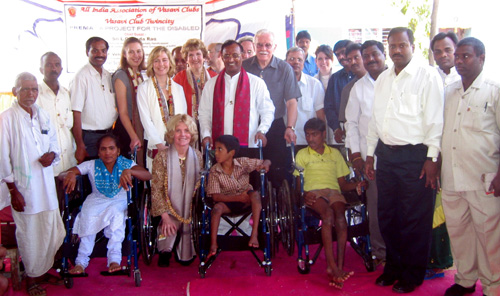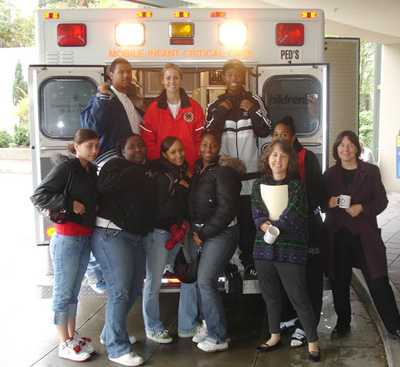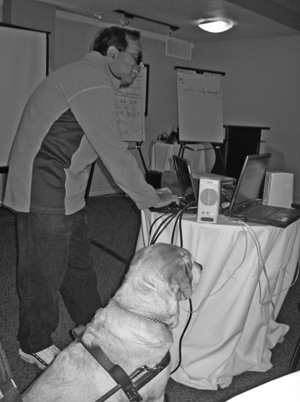DO-IT Ambassador: For travelers with mobility impairments, flying can be a serious pain, literally as well as figuratively. If airlines are not willing to look into installing a section of seats that could be removed and then have the space used for wheelchairs, they need to ensure that transitions to a seat be as easy as possible. If there is someone who needs to transfer into a seat, the person should be able to move to the closest seat possible. Many times I have been drug down sections of the plane because I am not part of the first or business classes. Some aisle seats do not have armrests that can be moved and are not conducive for transferring. Because the aisles in the planes are extremely narrow the chair they use for transferring is extremely narrow and a person can barely fit.
I would prefer that controls be on the inner portion of the seat since I often bring my seat cushion on board (otherwise I get extremely uncomfortable), and I hate having people dig for the volume on the plane. In the end most of my challenges on a plane come down to space.
DO-IT Mentor: What in-flight movies???? I thought they went the way of in-flight meals! Here are a few of my suggestions:
- On flights four hours or longer, a toilet room with a doorway wide enough for a caregiver/parent to assist a disabled person with toileting should be available. Specific ideas include curtains that can be drawn around the doorway opening to provide a larger privacy area, wider doorways, longer grab bars on the side walls, and positioning the sink and accessories within reach of the doorway or toilet seat.
- Put controls and call buttons on the armrest or seat back in front of you rather than overhead. I am short in stature and I can't reach any controls for air, light, or calling for assistance. They are WAY over my head.
- Provide optional foot supports for the short statured adults and children. My feet dangle during flights which is not good for circulation.
DO-IT Ambassador: Here are a couple of improvements that might benefit the visually impaired:
- Put Braille markings on the call button. In most of the planes I have ridden on, the call button is just a flat panel on the ceiling. There is not a good way for me to feel where the call button is. This issue could be resolved by simply putting a Braille sign on the button that says, "call" or "attendant."
- Provide spoken messages indicating whether the seatbelt sign is on or off. On most of the planes I have ridden in, the tone for the seatbelt sign is the same regardless of whether the sign is on or off. An alternative to a spoken message is to vary the tone. There could be a high tone when the seatbelt sign is turned on and a low tone when the sign is off.
DO-IT Scholar: I think they should have hand rails on the aisle seats so people with mobility impairments that need support to walk can get to the restroom. Most of the time I fly by myself and I am not comfortable asking for help to get to the restroom. I also think that the aisles should be wider and airline staff should be trained in how to assist a disabled person in an emergency—for example, if something happens to the plane and someone who can't walk needs to get off quickly. Also they should have interpreters for the deaf in case of an emergency so they too know what is going on.
DO-IT Ambassador: Definitely more space in the bathrooms is needed. Most already have grab bars that are helpful. Also labeling things in Braille would be good. Flight attendants are generally very helpful, and that's a plus. Until they design a commercial flight where you can keep a wheelchair on board, I'm not sure what else to suggest.
DO-IT Scholar: I'm 18 years old and I have many disabilities; the main one is that I'm a Little Person with a syndrome called Morquio's that causes me to use a power wheelchair as I have trouble walking. They should make the airplane seats, aisles, and bathrooms bigger for people with mobility issues and have signs, call buttons, etc., in Braille for people who are blind or have visual impairments. I think they should design the passenger areas to have room for all kinds of wheelchairs in them, just like the city buses.
DO-IT Scholar: I think airplanes should have a bigger bathroom (much bigger!) with bars so you can hang on. I use a walker on the plane and I usually crash my way to the bathroom holding on the back of the chairs. Even people who do not use wheelchairs, like me, would appreciate both the aisles and the bathroom being more accessible! I can't imagine how people in wheelchairs go to the bathroom on a plane; the bathrooms are so tiny! How do people using wheelchairs get to the restroom when flying?
DO-IT Ambassador: I don't even attempt to use bathrooms on the plane, just too hard!
DO-IT Ambassador: Yeah, whenever my wife and I fly over four hours, we intentionally get a layover so I can use the restroom at the airport between flights.
DO-IT Scholar: So you never go to the restroom on the plane? What happens if you really have to go?
DO-IT Ambassador: Never had it happen, but we'd have one of the airline attendants hold a blanket like a curtain so I could go.
DO-IT Scholar: I never go to the restroom on the plane. It's much easier to go in the airport because the restrooms are a lot bigger.
DO-IT Mentor: One thing I would really like to see is that buttons for calling the flight attendant, turning on the light, etc., are distinguishable from each other. In some planes these buttons are mounted in one strip at the underside of the overhead compartment, but the different buttons are not distinguishable by touch.
Also, as some others have mentioned, controls on the inside of your armrest or overhead can be difficult to reach. Placing the controls on the back of the seat in front of you could cause the person sitting in that seat to be bothered when the buttons are operated, so some kind of fortification of the area around the buttons might be useful in that case. It would also be nice if bathroom doors carried some type of identification including a label "push here to open", or whatever is appropriate, in both large print and Braille. When looking for the restroom on the plane, I'm often not exactly sure where I should pull or push and hesitate to try something for fear of setting off some alarm or opening a door I shouldn't be opening.
DO-IT Ambassador: The problem with having buttons on the back of the seats is if the person in front of you is reclined it could be hard to reach the buttons.
DO-IT Mentor: The entertainment systems are becoming more and more interactive and, thereby, less and less accessible to those of us who cannot read the screen. The systems are probably designed by each airline, but perhaps Boeing can do some things to help make them accessible.
DO-IT Ambassador: The seating system for people in wheelchairs that can't transfer well or at all needs to be changed. I think there should be a way to allow the passenger to remain in his or her wheelchair. One possible way to do this is to have a section of removal seats at the front of the plane. These seats could be removed and then a wheelchair occupant could park in that place. It should be fairly simple to have straps to tie a wheelchair down like in buses. The only possible problem would be the width of the airplane door. That is one thing that definitely needs to be fixed.
DO-IT Scholar: Would it be unsafe to have a wheelchair in the passenger cabin of the airplane? If they are able to make it really secure that would be great!
DO-IT Ambassador: I would think having chairs on board would be unsafe. Even during take off/landing it would potentially move... not to mention if something were to happen during the flight. I have no desire to be trapped under a 300lb chair. I think the plane seats are bolted down, but I may be COMPLETELY wrong. How would someone in a wheelchair that is secured move around, go to bathroom, etc., and still stay secure?
DO-IT Ambassador: There should be wider and bigger entrance doors so wheelchairs can fit. A way to tie down similar to those on a bus would be WONDERFUL. Also a place to store manual chairs or scooters for people who choose to sit in an airplane seat would be helpful. I just got back from a vacation in Wisconsin, and my family took the train so I could keep my power chair.
DO-IT Ambassador: The main safety concern with wheelchairs is not that they won't be able to tie them down to the plane but what is actually within the chair. When a wheelchair is put on the plane in the cargo bay they are sure to disconnect the batteries and separate those as well as inspect all other wiring for potential explosive devices. Allowing a wheelchair on the plane would simply alleviate the problems that are caused by transferring to another seat. The problem of space for a chair on the plane is a simple matter of money—first class eliminated a number of seats and the seating space grew wider in general, but to compensate they charge more for each seat. If there were some sort of monetary incentive for the airline operators to operate more accessible planes, I think they'd be more willing to change.
DO-IT Ambassador: Most aircraft use a track system to connect the seats to the floor. So they could have a system that has a special wheelchair designed to act as your seat and it could then be connected to the floor using the track.
DO-IT Ambassador: I always have a hard time reading on planes. If the top of the tray could be covered in non-stick material, that would help so much!
DO-IT Mentor: Great ideas! Here are a few more (sorry for any redundancy)
- Some Braille labels on the buttons—the call button, air, etc.
- More room in the bathroom would also allow those of us with service dogs to have them with us in the bathroom and thus eliminate the need to either leave the dog alone or have the flight attendant hold the dog.
- Braille or taped instructions of where everything is in the bathroom.
- Special airline-sponsored training for small groups of people with disabilities who are interested in experiencing a total simulated emergency evacuation including opening the emergency exit doors and sliding down the inflatable tubes.
DO-IT Mentor: I agree 100% with you. Presently, I leave my guide dog by my chair when going to the bathroom and so far it has not been a problem. Of course, it helps to have a bigger restroom as all service dogs are not the same and some need to stay with their masters.
DO-IT Mentor: Ditto about Braille labeling. I cannot find the flusher in some airplanes and also the call button. I always have to ask flight attendants where things are.
DO-IT Ambassador: During my last couple of trips, I have had some issues of my own. For example, at the end of spring term, I went by airline to Medford to see my mother and father. I was let off at the curbside check-in and was able to check in my suitcase. However, I had trouble getting assistance to the security checkpoint and boarding gate. The man at the curbside check-in took me into the building and said he was going to call someone to take me to the boarding gate. However, it was over thirty minutes and no one came. In fact, I didn't get assistance through security until close to time for my flight to take off.
During my last trip, I had trouble getting assistance to the ground transportation center. I landed in Portland and the attendant was going to call the airport to have someone meet me at the plane and take me where I needed to go. However, no one showed up by the time I landed. In fact, it took over twenty minutes just to get assistance to baggage claim. When you are traveling, how do you resolve the problem of getting assistance to your destination?
DO-IT Ambassador: The airlines ALWAYS unplug the batteries to my chair and forget they've done it, leaving me to put the pieces back together. It always takes awhile to find the seat cushion too. We've taken to removing the cushion and using it for extra cushioning on the airline seat...not a bad solution. Sometimes they take an interminably long time with the aisle chair, but, other than being really frustrating, it's usually not a problem to wait. The one time I needed something quickly—when I was interviewing in Chicago for a Mellon Fellowship—they actually got it right! My worst airport experience was actually while still on the ground. Note to others: I could find no accessible bathrooms at Dulles International Airport near the terminals. Yes, this meant waiting about eight hours for a catheterization and I was seriously paying for it. That was along time ago and I wouldn't be surprised if things have changed.
DO-IT Mentor: I travel frequently for business and leisure and use a manual wheelchair. I require assistance boarding and deplaning. I often wait twenty minutes once a plane lands to get off the plane (all passengers must deplane, then they bring the aisle chair and assist me to my wheelchair, waiting in the jet way.) Sometimes my wheelchair hasn't appeared from down below yet, sometimes the special services staff aren't yet available—who knows. Patience is necessary when you travel. I warn folks who might be waiting for me in baggage that I usually don't show up for thirty minutes after a plane lands.
Now about getting through security, I would ask the fellow at curbside check-in to take you to a person at the counter of the airline you are flying. Your physical presence in front of them will urge them to get those special services staff to you more quickly. Plus, you will have someone you can keep checking in with to be sure you get your needed assistance in a timely manner.
DO-IT Ambassador: Thanks for the recommendations. Next time I fly out, I will get directed to the ticket counter inside the terminal instead of using curb side check-in. What do you think of the idea of contacting the airline and arranging assistance before I arrive?
DO-IT Ambassador: I only have tried to travel with my electric wheelchair on a plane twice and my wheelchair got there fine but didn't make it back home in one piece both times. The second time that we traveled with my wheelchair, we tried putting notes on my chair but we didn't think about the fact that not everyone can read the English language. So, my dad and I came up with an idea for the traveling companies to have a box that the power wheelchair could go into with handles on the outside of the box so it would make it easier for the workers to pick up to lift.
DO-IT Ambassador: I just got back from New York City where there was a miscommunication with the hotel shuttle, and I gave them a piece of my mind. Airport shuttles are the worst for me in terms of accessibility, but I usually leave a larger tip, so the hassle decreases.
It's great that some of you use your parents as resources, but there may be times when they aren't there. Be objective, confident, and persistent too. You have to have patience with people. I fill out forms regarding my chair and tell them what might be vulnerable pieces of the chair. I say things like "lift from here." I've been fortunate that they've never dropped or bent my chair (at least no more than my brothers have), and I have escaped with no damage.
If your chair ever is damaged you should report this. I'm just wondering why some of you dismantle your chair? Is it because of the batteries? It helps to leave your seat cushion by your feet. I've forgotten mine in an overhead bin a few times.
DO-IT Scholar: I have two power wheelchairs so I take the old one. I'm thinking about the wheelchair all the way to where I'm going because I'm scared about it. My mom takes the joystick off because before we did that it got messed up badly and it made the chair harder to drive. I like the idea of making signs in different languages about how to handle the wheelchair if it gets stored on a plane—just like the multi-language signs they have in airports to assist travelers.
From this conversation here is a list of some of the suggestions the DO-IT community recommends that airlines consider to make all passengers, including those with disabilities, feel welcome and make the environment usable by everyone:





